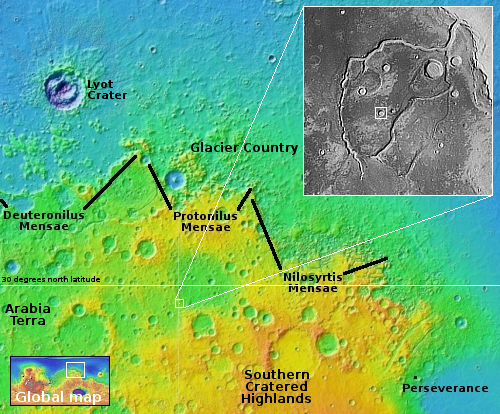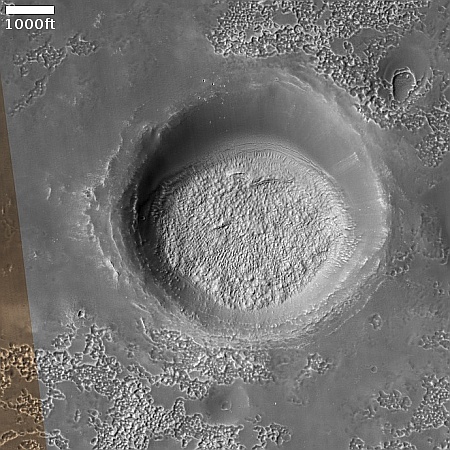Sublimating ice in the Martian dry tropics?
Cool image time! The picture to the right, cropped, reduced, and sharpened to post here, was taken on May 3, 2025 by the high resolution camera on Mars Reconnaissance Orbiter (MRO). Labeled merely as a “terrain sample,” it was likely snapped not as part of any specific research project but to fill a gap in the camera’s schedule so as to maintain the camera’s proper temperature.
When the MRO camera team does this, they try to pick features of interest at the time required, and I think succeed more often than not. In this case, they captured this one-mile-wide unnamed crater that appears to be filled with sublimating glacial debris. Similarly, the plateau surrounding the crater seems to also show signs that some sublimation is occurring of ice just below the surface, producing the areas that appear filled with pockmarks.
The location however suggests that if near surface ice here is sublimating away, it hints at a find of some significance.

The white dot on the overview map to the right marks the location, well inside the dry Martian tropics at 28 degrees north latitude, and about 500 miles south of the 2,000-mile-long mid-latitude region I dub glacier country because practically every image shows extensive glacial features.
Based on almost all orbital data, there should be no near surface ice at this latitude.
Yet the picture above as well as the inset on the overview map suggests otherwise. The inset shows that this crater is on a plateau with a number of similar craters as well as a meandering tributary canyon system that drains into a lower valley about eighteen miles away.
All the features suggest that there might be a layer of underground ice here, even though it is in Mars’ dry equatorial tropics. And if that ice is gone, the geology suggests there was once a lot, and it once flowed downhill in those canyons to the valley.
Was the flow liquid water or glacial ice? That remains the $64,000 scientific question. And is there still near surface ice at this low latitude? That’s another $64,000 question.
On Christmas Eve 1968 three Americans became the first humans to visit another world. What they did to celebrate was unexpected and profound, and will be remembered throughout all human history. Genesis: the Story of Apollo 8, Robert Zimmerman's classic history of humanity's first journey to another world, tells that story, and it is now available as both an ebook and an audiobook, both with a foreword by Valerie Anders and a new introduction by Robert Zimmerman.
The print edition can be purchased at Amazon or from any other book seller. If you want an autographed copy the price is $60 for the hardback and $45 for the paperback, plus $8 shipping for each. Go here for purchasing details. The ebook is available everywhere for $5.99 (before discount) at amazon, or direct from my ebook publisher, ebookit. If you buy it from ebookit you don't support the big tech companies and the author gets a bigger cut much sooner.
The audiobook is also available at all these vendors, and is also free with a 30-day trial membership to Audible.
"Not simply about one mission, [Genesis] is also the history of America's quest for the moon... Zimmerman has done a masterful job of tying disparate events together into a solid account of one of America's greatest human triumphs."--San Antonio Express-News
Cool image time! The picture to the right, cropped, reduced, and sharpened to post here, was taken on May 3, 2025 by the high resolution camera on Mars Reconnaissance Orbiter (MRO). Labeled merely as a “terrain sample,” it was likely snapped not as part of any specific research project but to fill a gap in the camera’s schedule so as to maintain the camera’s proper temperature.
When the MRO camera team does this, they try to pick features of interest at the time required, and I think succeed more often than not. In this case, they captured this one-mile-wide unnamed crater that appears to be filled with sublimating glacial debris. Similarly, the plateau surrounding the crater seems to also show signs that some sublimation is occurring of ice just below the surface, producing the areas that appear filled with pockmarks.
The location however suggests that if near surface ice here is sublimating away, it hints at a find of some significance.

The white dot on the overview map to the right marks the location, well inside the dry Martian tropics at 28 degrees north latitude, and about 500 miles south of the 2,000-mile-long mid-latitude region I dub glacier country because practically every image shows extensive glacial features.
Based on almost all orbital data, there should be no near surface ice at this latitude.
Yet the picture above as well as the inset on the overview map suggests otherwise. The inset shows that this crater is on a plateau with a number of similar craters as well as a meandering tributary canyon system that drains into a lower valley about eighteen miles away.
All the features suggest that there might be a layer of underground ice here, even though it is in Mars’ dry equatorial tropics. And if that ice is gone, the geology suggests there was once a lot, and it once flowed downhill in those canyons to the valley.
Was the flow liquid water or glacial ice? That remains the $64,000 scientific question. And is there still near surface ice at this low latitude? That’s another $64,000 question.
On Christmas Eve 1968 three Americans became the first humans to visit another world. What they did to celebrate was unexpected and profound, and will be remembered throughout all human history. Genesis: the Story of Apollo 8, Robert Zimmerman's classic history of humanity's first journey to another world, tells that story, and it is now available as both an ebook and an audiobook, both with a foreword by Valerie Anders and a new introduction by Robert Zimmerman.
The print edition can be purchased at Amazon or from any other book seller. If you want an autographed copy the price is $60 for the hardback and $45 for the paperback, plus $8 shipping for each. Go here for purchasing details. The ebook is available everywhere for $5.99 (before discount) at amazon, or direct from my ebook publisher, ebookit. If you buy it from ebookit you don't support the big tech companies and the author gets a bigger cut much sooner.
The audiobook is also available at all these vendors, and is also free with a 30-day trial membership to Audible.
"Not simply about one mission, [Genesis] is also the history of America's quest for the moon... Zimmerman has done a masterful job of tying disparate events together into a solid account of one of America's greatest human triumphs."--San Antonio Express-News



My guess for what caused the crater – a 1-mile diameter wadcutter round, made of water-ice. At the time of impact, there was a local-system ban on the use of heavy-metals for large-caliber shooting, hence water was next up. You know how effective test-ban treaties are on earth. Who knew even aliens have their quirks! Makes for an interesting pix though.
Heh.